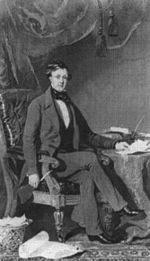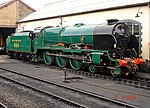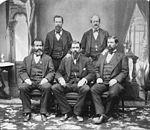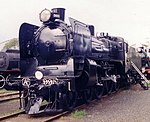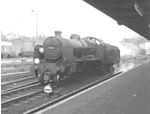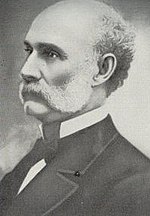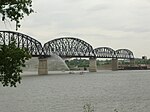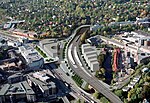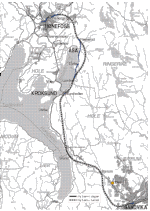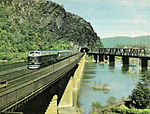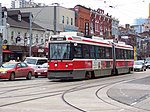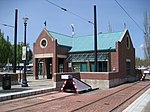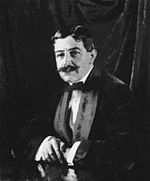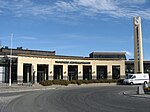Portal:Trains/Selected article/2008 archive
This is an archive of article summaries that have appeared in the Selected article section of Portal:Trains in 2008. For past archives, see the complete archive page.
The class E 10 is an electric locomotive class of the Deutsche Bundesbahn, introduced in 1952. It belongs to the so-called Einheits-Elektrolokomotiven (standardised electric locomotives) program and was built for express passenger service. The class was designed with largely standardised components and was one of the first German locomotive classes that included seats for the engineers (whereas formerly they had to stand in order to boost their attentiveness). In 1968 the series was redesignated as class 110 (E10) and class 112 (E10.12). In 1988 the last series of class 112 locomotives were designated as class 114, and in 1991 the remaining locomotives of class 112 were designated as class 113. In 2006, 38 locomotives were designated as class 115. The five prototypes of this class were taken out of service between 1975 and 1978; of these E 10 003 and E 10 005 were preserved as museum locomotives.
Recently selected: Otto Kuhler - 2005 New York City transit strike - LSWR M7 Class
- Week 2
- January 6-January 12
The sleeping car or sleeper is a railroad passenger car that can accommodate all its passengers in beds of one kind or another, primarily for the purpose of making nighttime travel more restful. The first such cars saw sporadic use on American railroads in the 1830s and could be configured for coach seating during the day. Some of the more luxurious types have private rooms, that is to say fully- and solidly-enclosed rooms that are not shared with strangers. In the United States today, all regularly-scheduled sleeping car services are operated by Amtrak. Amtrak offers sleeping cars on most of its overnight trains, using modern cars of the private-room type exclusively. In Canada, all regularly scheduled sleeping car services are operated by VIA Rail Canada, using a mixture of relatively-new cars and refurbished mid-20th century cars; the latter cars include both private rooms and "open section" accommodations. An example of a more basic type of sleeping car is the European couchette car, which is divided into compartments for four or six people, with bench-configuration seating during the day and "privacyless" double- or triple-level bunk-beds at night. Even more basic is the Chinese "hard" sleeping car in use today, consisting of fixed bunk beds, which cannot be converted into seats, in a public space. Chinese trains also offer "soft" or deluxe sleeping cars with four beds per room.
Recently selected: DB Class E 10 - Otto Kuhler - 2005 New York City transit strike
- Week 3
- January 13-January 19
The BR Standard Class 7, otherwise known as the Britannia Class, is a class of 4-6-2 Pacific steam locomotive designed by Robert Riddles for use in the United Kingdom by British Railways for mixed traffic duties. Fifty-five were constructed between 1951 and 1954. The design was a result of the 1948 locomotive exchanges undertaken in advance of further locomotive classes being constructed. Three batches were constructed at Crewe Works, before the publication of the 1955 Modernisation Plan. The Britannias Class was based on several previous locomotive designs, incorporating the best practices in locomotive technology as regards labour-saving and lowering maintenance costs; various weight-saving measures also increased the route availability of a Pacific-type locomotive on the British Railways network. The Britannias received a positive reception from their crews, with those regularly operating the locomotives giving them favourable reports as regards performance. However, trials in some areas of the British Railway network returned negative feedback, primarily due to indifferent operation of the locomotive, with its effects on adhering to timetables. The Britannias took their names from great Britons, former Star Class locomotives, and Scottish firths. The class remained in service until the last was withdrawn in 1968. Two survived into preservation, the doyen, number 70000 Britannia, and 70013 Oliver Cromwell. Only number 70000 has seen service on the railway network since 1968.
Recently selected: Sleeping car - DB Class E 10 - Otto Kuhler
- Week 4
- January 20-January 26
The Port Authority Trans-Hudson (PATH) is a rapid transit railroad linking Manhattan, New York, with New Jersey, and providing service to Jersey City, Hoboken, Harrison, and Newark. It is operated by the Port Authority of New York and New Jersey. PATH is one of the few rapid transit systems in the world that operates 24 hours a day, 7 days a week. While some PATH stations are adjacent to New York City Subway, Newark Light Rail and Hudson-Bergen Light Rail stations, there are no free transfers as the four systems operate independently. PATH spans 13.8 miles (22.2 km) of route mileage, not including any route overlap. PATH trains only use tunnels in Manhattan and parts of New Jersey (specifically, Hoboken and downtown Jersey City). The tracks cross the Hudson River through century-old cast iron tubes that rest on the river bottom under a thin layer of silt. PATH's routes from Grove Street in Jersey City west to Newark run in open cuts, at grade level, and on elevated track. As of 2006, PATH has an average weekday ridership of 239,200.
Recently selected: BR Standard Class 7 - Sleeping car - DB Class E 10
- Week 5
- January 27-February 2
Britomart Transport Centre (often simply Britomart), is the Auckland, New Zealand, central business district transport hub. It combines a bus interchange and railway station in an Edwardian former post office (extended with expansive post-modernist architectural elements), with the main ferry terminal being just across Quay Street. It is located at the foot of Queen Street, the main commercial thoroughfare of Auckland's central business district. At the time of its inception, the centre was Auckland's largest transport project ever and is also one of the few underground railways stations in the world where diesel motive power is used. It is the northern terminus of the North Island Main Trunk line. The centre was built to move rail access closer to the city's central business district and thereby help boost Auckland's low usage of public transport.
Recently selected: Port Authority Trans-Hudson - BR Standard Class 7 - Sleeping car
- Week 6
- February 3-February 9
The SR Class Q1 is a type of austerity steam locomotive constructed during the Second World War. The class was designed by Oliver Bulleid for use on the intensive freight turns experienced during wartime on the Southern Railway network. A total of 40 locomotives were built. Bulleid incorporated many innovations and weight-saving concepts to produce a highly functional design. The class lasted in service until July 1966, and the doyen of the class, C1, has been preserved by the National Railway Museum. The highly unusual and controversial design represents the ultimate development of the British 0-6-0 freight engine, capable of hauling trains that were usually allocated to much larger locomotives on other railways
Recently selected: Britomart Transport Centre - Port Authority Trans-Hudson - BR Standard Class 7
- Week 7
- February 10-February 16
The Indiana Railroad (IR) was the last of the typical Midwestern United States interurban lines. It was formed in 1930 by combining the operations of the five major interurban systems in central Indiana into one entity. The predecessor companies had all previously come under the control of Midland Utilities, owned by Samuel Insull. It was Insull's plan to consolidate the Indiana interurban network, modernizing the profitable routes and abandoning the unprofitable ones. With the onset of the Great Depression, the Insull empire collapsed and the Indiana Railroad was left with a decaying infrastructure and little hope for overcoming the competition of the automobile. During the 1930s the Indiana Railroad's lines were all abandoned one by one until a wreck in 1941 put an end to the last operation of typical interurban lines in Indiana.
Recently selected: SR Class Q1 - Britomart Transport Centre - Port Authority Trans-Hudson
- Week 8
- February 17-February 23
The Channel Tunnel (French: le tunnel sous la Manche), also known as Chunnel or Eurotunnel is a 50.450 km (31.35 mi) long rail tunnel beneath the English Channel at the Strait of Dover, connecting Folkestone, Kent in England (51°5′49.5″N 1°9′21″E / 51.097083°N 1.15583°E) to Coquelles near Calais in northern France (50°55′22″N 1°46′50.16″E / 50.92278°N 1.7806000°E). The "tunnel" consists of three separate tunnels; two 7.6 m (25 ft) diameter single track, single direction rail tunnels which are 30 m (98 ft) apart and one 4.8 m (16 ft) diameter service tunnel between them. It was a megaproject with several false starts, but it was finally completed in 1994. It is the second-longest rail tunnel in the world, with the Seikan Tunnel in Japan being longer, but the undersea section of the Channel Tunnel, at 37.9 km (23.55 mi), is the longest undersea tunnel in the world. The American Society of Civil Engineers has declared the tunnel to be one of the Seven Wonders of the Modern World.
Recently selected: Indiana Railroad - SR Class Q1 - Britomart Transport Centre
- Week 9
- February 24-March 1
Thomas Brassey (7 November 1805 – 8 December 1870) was an English civil engineering contractor and manufacturer of building materials who was responsible for building much of the world's railways in the 19th century. By 1847, he had built about one-third of the railways in Britain, and by time of his death in 1870 he had built one mile in every 20 miles of railway in the world. This included three-quarters of the lines in France, major lines in many other European countries and in Canada, Australia, South America and India. He also built the structures associated with those railways, including docks, bridges, viaducts, stations, tunnels and drainage works. As well as railway engineering, Brassey was active in the development of steamships, mines, locomotive factories, marine telegraphy, and water supply and sewage systems. He built part of the London sewerage system and was a major shareholder in Brunel's The Great Eastern, the only ship large enough at the time to lay the first transatlantic telegraph cable across the North Atlantic, in 1864.
Recently selected: Channel Tunnel - Indiana Railroad - SR Class Q1
The BR Standard Class 8 was a class of 4-6-2 Pacific steam locomotive designed by Robert Riddles for use by British Railways. Only the prototype was constructed, which was named Duke of Gloucester. Constructed at Crewe Works in 1954, the Duke, as it is also referred to, was a replacement for the destroyed Princess Coronation Class locomotive number 46202 Princess Anne, which was involved in the Harrow and Wealdstone rail disaster of 1952. The Duke was based on the BR Standard Class 7 Britannia design. It incorporated three sets of modified Caprotti valve gear, relatively new to British locomotive engineering, and more efficient than two sets of Walschaerts or Stephenson valve gear. The Duke was regarded as a failure by locomotive crews due to its poor steaming characteristics and its heavy fuel consumption. Trials undertaken by British Railways also returned negative feedback, reporting problems with the poor draughting of the locomotive having an adverse effect on adhering to timetables. The result was an operational period of only eight years. This unique locomotive was saved from being scrapped at Woodhams' Scrapyard when it was purchased by a group of railway enthusiasts who restored it from scrapyard to as-built condition in 13 years. Since then, modifications have been made to the original design, resulting in one of the most efficient and powerful locomotives ever to run in Britain. As a result, the Duke of Gloucester can frequently be seen on the mainline around Britain.
Recently selected: Thomas Brassey - Channel Tunnel - Indiana Railroad
The Denver and Rio Grande Railroad (reporting mark DRG and DRGW), generally referred to as the Rio Grande, became the Denver and Rio Grande Western Railroad in 1920, and is today a fallen flag (a railroad that has been absorbed into a larger system — Southern Pacific Railroad — as the result of a merger). The D&RGW served mainly as a transcontinental bridge line between Denver, Colorado, and Salt Lake City, Utah, and as a major origin of coal and mineral traffic, with a motto of Through the Rockies, not around them. The Rio Grande was the epitome of mountain railroading, operating the highest mainline rail line in the United States, the over 10,240 ft (3,121 m) Tennessee Pass in Colorado, and the famed routes through the Moffat Tunnel and the Royal Gorge. At its height, around 1890, the D&RG had the largest operating narrow gauge railroad network in North America. Known for its independence, the D&RGW operated the last private longhaul passenger train in the United States, the Rio Grande Zephyr.
Recently selected: BR Standard Class 8 - Thomas Brassey - Channel Tunnel
Rail transport in Victoria, Australia, is provided by a number of railway operators who operate over the government owned railway lines. Victorian lines use 5 ft 3 in (1,600 mm) broad gauge, with the exception of a number of standard gauge 4 ft 8+1⁄2 in (1,435 mm) freight and interstate lines, a few experimental 2 ft 6 in (762 mm) narrow gauge lines, and various private logging, mining and industrial railways. Railways were privately owned and operated, until the State Government established the vertically integrated Victorian Railways in 1883. This remained until corporatisation occurred in the 1980s, followed by privatisation in the 1990s. Passenger services today are operated by Connex Melbourne in suburban Melbourne with electric multiple units, and V/Line in regional Victoria with diesel trains. Freight is operated by Pacific National and other private operators such as El Zorro, Specialised Container Transport and QRNational. The rail network radiates from the state capital, Melbourne, with two main interstate links to Sydney and Adelaide, as well as major lines running to regional centres, upgraded as part of the Regional Fast Rail project. The rail network reached a peak in 1942 but steadily declined, as branch and cross country lines were closed up to the 1980s. Victoria does not have a dominant mining base as with other states, and has traditionally been more dependent on agriculture for rail freight traffic. By the 1990s road transport had captured most general freight traffic, with an average of only 6.1 million tonnes of intrastate freight carried each year between 1996 and 1998; containers being the major cargo, followed by cement, logs, quarry products, and steel.
Recently selected: Denver and Rio Grande Western Railroad - BR Standard Class 8 - Thomas Brassey
The SR Class LN or Lord Nelson Class is a class of 4-6-0 steam locomotive designed for the Southern Railway by Richard Maunsell. Intended for express passenger work to the South-West of England. Sixteen of this type were constructed at Southern's Eastleigh Works between 1926 and 1929; they represented the ultimate in Southern 4-6-0 design. They followed Southern Railway practice of naming their express passenger types, in this case after famous admirals. The class continued to operate with British Railways until 1961, after modifications were made to the blastpipe by Oliver Bulleid. The class was withdrawn in 1961, and only one example of the class has been preserved. Lord Nelson can be seen running on mainline tours throughout Britain.
Recently selected: Rail transport in Victoria - Denver and Rio Grande Western Railroad - BR Standard Class 8
Trench railways represented military adaptation of early 20th century railway technology to the problem of keeping soldiers supplied during the static trench warfare phase of World War I. The large concentrations of soldiers and artillery at the front lines required delivery of enormous quantities of food, ammunition and fortification construction materials where transportation facilities had been destroyed. Reconstruction of conventional roads and railways was too slow, and fixed facilities were attractive targets for enemy artillery. Trench railways linked the front with standard gauge railway facilities beyond the range of enemy artillery. Empty cars often carried litters returning wounded from the front. France had standardized 600 mm (1 ft 11+5⁄8 in) gauge military Decauville equipment and Germany adopted similar feldbahn of the same gauge. British War Department Light Railways and the United States Army Transportation Corps used the French 600 mm gauge system. Russia used Decauville 600 mm and 750 mm (2 ft 5+1⁄2 in) systems. Unskilled laborers and soldiers could quickly assemble prefabricated 5-metre (16 ft) sections of track weighing about 100 kilograms (220 lb) along roads or over smooth terrain. The track distributed heavy loads to minimize development of muddy ruts through unpaved surfaces. Small locomotives pulled short trains of ten-tonne capacity cars through areas of minimum clearance and small-radius curves. Derailments were common, but the light rolling stock was relatively easy to rerail. Steam locomotives typically carried a short length of flexible pipe (called a water-lifter) to refill water tanks from flooded shell holes. Steam locomotives produced enough smoke to reveal their location to enemy artillery, so they required fog or darkness to operate within visual range of the front. Daylight transport usually required animal power until internal combustion locomotives were developed. Large quantities of hay and grain were carried to the front while horses remained an essential part of military logistics.
Recently selected: SR Lord Nelson Class - Rail transport in Victoria - Denver and Rio Grande Western Railroad
Union Station is the major inter-city rail station and a major commuter rail hub in Toronto, Ontario, Canada. The station is located on Front Street West and occupies the south side of the block bounded by Bay Street and York Street in the central business district. The station building is owned by the City of Toronto, while the trainshed and trackage east and west of the station is owned by the commuter rail operator GO Transit. Serving 200,000 passengers a day, it is the busiest passenger transportation facility in Canada. Union Station is at the centre of the Quebec City – Windsor Corridor, the busiest inter-city rail service area in the nation (marketed as the Corridor), which extends from Windsor and Sarnia in the west to Ottawa, Montreal and Quebec City in the east. Inter-city trains at Union Station are operated by VIA Rail, Amtrak and Ontario Northland, while commuter rail services are operated by GO Transit. The station is also connected to the Toronto Transit Commission (TTC) subway system. The station saw 2.34 million VIA Rail boardings in 2004, more than half of all VIA passengers carried that year. Additionally, Union Station is the central terminal for GO Transit, handling approximately 41 million GO Transit commuter rail passengers and 20 million TTC subway passengers in 2004.
Recently selected: Trench railways - SR Lord Nelson Class - Rail transport in Victoria
The Mussel Slough Tragedy was a dispute over land titles between settlers and the Southern Pacific Railroad (SP) that took place on May 11, 1880 on a farm located 5.6 miles (9 km) northwest of Hanford, California in the central San Joaquin Valley, leaving seven people dead. Frank Norris' 1901 novel, The Octopus: A California Story, was inspired by this incident, as was W. C. Morrow's 1882 novel Blood-Money. The exact history of the tragedy has been the source of some disagreement, due to a popular anti-railroad sentiment in the 1880s which saw the tragedy as a clear example of corrupt and cold-blooded corporate greed. Muckraking journalists and anti-railroad activists glorified the settlers and used the tragedy as evidence and justification for their anti-corporate crusades. The site of the episode is now registered as California Historical Landmark #245. The historical marker is at 36°23′21″N 119°42′31″W / 36.38917°N 119.70861°W on the east side of 14th Avenue, 350 yards (320 m) north of Elder Avenue.
Recently selected: Union Station (Toronto) - Trench railways - SR Lord Nelson Class
The Talyllyn Railway (Welsh: Rheilffordd Talyllyn) is a narrow-gauge preserved railway running for 7¼ miles (11.8 km) from Tywyn on the Mid-Wales coast to Nant Gwernol near the village of Abergynolwyn. The line was opened in 1866 to carry slate from the quarries at Bryn Eglwys to Tywyn, and was the first narrow gauge railway in Britain authorised by Act of Parliament to carry passengers using steam haulage. Despite severe under-investment, the line remained open, and in 1951 it became the first railway in the world to be preserved as a heritage railway by volunteers. Since preservation, the railway has operated as a tourist attraction. It has significantly expanded its rolling stock through acquisition and an engineering programme to build new locomotives and carriages. In 1976 an extension was opened along the former mineral line from Abergynolwyn to the new station at Nant Gwernol. In 2001 the preservation society celebrated its 50th anniversary. In 2005 a major rebuilding and extension of Tywyn Wharf station was opened, including a much expanded facility for the Narrow Gauge Railway Museum. The origin of the railway's name is uncertain: it is thought to refer to the parish of Tal-y-llyn, which contains its eastern terminus, or it may come from Tal-y-llyn, a large glacial ribbon lake at the foot of Cadair Idris 3 miles (5 km) further east. The gauge of the track is 2 ft 3 in (686 mm). This is an unusual gauge, and was shared by only three other public railways in the United Kingdom: the nearby Corris Railway (which predated the Talyllyn), and the subsequent Plynlimon and Hafan Tramway and Campbeltown and Machrihanish Light Railway.
Recently selected: Mussel Slough Tragedy - Union Station (Toronto) - Trench railways
The ALCO FA was a family of B-B diesel locomotives designed to haul freight trains. The locomotives were built by a partnership of ALCO and GE in Schenectady, New York, between January 1946 and May 1959. They were of a cab unit design, and both cab-equipped lead (A unit) FA and cabless booster (B unit) FB models were built. A dual passenger-freight version, the FPA/FPB, was also offered. It was equipped with a steam generator for heating passenger cars. Externally, the FA and FB models looked very similar to the ALCO PA models produced in the same period. Both the FA and PA models were styled by GE's Ray Patten. They shared many of the same characteristics both aesthetically and mechanically. It was the locomotive's mechanical qualities (the ALCO 244V12 prime mover) and newer locomotive models from both General Motors Electro-Motive Division (EMD) and General Electric (the partnership with ALCO was dissolved in 1953) that ultimately led to the retirement of the locomotive model from revenue service. Several examples of FAs and FBs have been preserved in railroad museums, a few of them in operational states on such lines as the Grand Canyon Railway in Arizona and the Napa Valley Wine Train in California.
Recently selected: Talyllyn Railway - Mussel Slough Tragedy - Union Station (Toronto)
The London and North Eastern Railway (LNER) Class A1/A3 represent two stages in the history of the British 4-6-2 "Pacific" steam locomotives designed by Nigel Gresley. They were designed for main line passenger services, initially on the Great Northern Railway (GNR), a constituent company of the London and North Eastern Railway after the amalgamation of 1923, for which they became a standard design. The change in class designation to A3 reflected the fitting to the same chassis of a higher pressure boiler with a greater superheating surface and a small reduction in cylinder diameter, leading to an increase in locomotive weight. Eventually all of the A1 locomotives were rebuilt to A3 specifications. The names for the locomotives came from a variety of sources. The first, Great Northern, was named after its parent company. Others were given the names of high-ranking railway officials, but most were given the names of famous racehorses. One was named after the company's most famous long-distance passenger train, the Flying Scotsman (also the name of a racehorse). Flying Scotsman is the sole survivor of the class to be preserved. As of 2008, it is under mechanical overhaul at the National Railway Museum.
Recently selected: ALCO FA - Talyllyn Railway - Mussel Slough Tragedy
The A2 class was an express passenger steam locomotive that ran on Victorian Railways (VR) in Australia from 1907 to 1963. A highly successful design entirely the work of Victorian Railways' own design office, its long service life was repeatedly extended as economic depression and war delayed the introduction of more modern and powerful replacement locomotives. The introduction of the A2 class marked a turning point in Victorian Railways locomotive design, as it was entirely designed by VR engineers of the newly established Locomotive Design Section and the entire class built in-house at Victorian Railways workshops. For over forty years, the A2 was the main express passenger locomotive on the VR, hauling intrastate and interstate services. With a maximum permitted speed of 70 miles per hour (110 km/h) the A2 was instrumental in the acceleration of timetables on many lines in the years following its introduction. They famously ran the Geelong Flier service (the first "named" train in Victoria) slashing journey times between Melbourne and Geelong from 90 minutes to 63 and finally 55 minutes, a time not significantly improved upon until the introduction of 100 mph (160 km/h) Regional Fast Rail services in 2006. In 1951 the A2 was finally superseded. In 1953, no fewer than 53 A2s went to scrap, followed by 36 more in 1954. However, many of the class continued on in secondary roles such as branch line passenger and goods services and a number lasted into the 1960s. Their last regular mainline duty was hauling services between Flinders Street Station and Leongatha, on the South Gippsland line. The last in service, A2 986, was withdrawn on 2 December 1963, exactly 56 years after the original A2 572 entered service.
Recently selected: LNER Class A1/A3 - ALCO FA - Talyllyn Railway
The Chemin de fer des Côtes-du-Nord (abbr. CdN, lit. Railway of the Côtes-du-Nord), the Côtes-d'Armor today, was a 1,000 mm (3 ft 3+3⁄8 in) gauge railway in Côtes-du-Nord, France, although there were a few kilometres of line in Finistère and Ille-et-Vilaine. The first lines opened in 1905 and final closure was in 1956. The lines were a voies ferrées d'intérêt local system with a total extent of 457 kilometres (284 mi). The system was constructed in two stages, the initial lines built between 1905 and 1907, and the extensions during and after the First World War which were opened between 1916 and 1926. These lines would make the CdN slightly bigger than the Réseau Breton. The first closures were in 1937, but the Second World War gave the CdN a stay of execution, and parts of the system remained open until 1956.
Recently selected: Victorian Railways A2 class - LNER Class A1/A3 - ALCO FA
Pennsylvania Station (commonly known as "Penn Station") is the major intercity rail station and a major commuter rail hub in New York City. The station is located in the underground levels of Pennsylvania Plaza, an urban complex at 8th Avenue and 31st Street in Midtown Manhattan, and is owned by Amtrak. Pennsylvania Station is named for the Pennsylvania Railroad (PRR), its builder and original tenant, and shares its name with several stations in other cities. The current facility is the substantially remodeled underground remnant of a much grander structure designed by McKim, Mead, and White and completed in 1910. The original Pennsylvania Station was an outstanding masterpiece of the Beaux-Arts style and one of the architectural jewels of New York City. The above-ground portion of the original structure was demolished in 1964 and replaced by the present Pennsylvania Plaza complex, including the fourth and current Madison Square Garden. Serving 600,000 passengers a day (compared to 140,000 across town at Grand Central Terminal) at a rate of up to a thousand every 90 seconds, Penn Station is the busiest passenger transportation facility in the United States and by far the busiest train station in North America. Penn Station is at the center of the Northeast Corridor, an electrified passenger rail line extending south to Washington, D.C., and north to Boston. Intercity trains are operated by Amtrak, while commuter rail services are operated by the Long Island Rail Road and New Jersey Transit. The station is also connected to six New York City Subway lines. Penn Station is the busiest Amtrak station in the United States. The station saw 4.3 million Amtrak boardings in 2004, more than double the traffic at the next busiest station, Union Station in Washington, D.C. Penn Station's assigned IATA airport code is ZYP, and its Amtrak and NJ Transit station code is NYP.
Recently selected: Chemin de fer des Côtes-du-Nord - Victorian Railways A2 class - LNER Class A1/A3
The SR U Class were 2-6-0 mogul steam locomotives designed by Richard Maunsell for passenger duties on the Southern Railway in Great Britain. They were to be used on cross-country and semi-fast expresses. A highly standardised class of locomotive, the U Class project was given greater emphasis after the Sevenoaks railway accident which involved another class of locomotive, Harry Wainwright's SECR K Class 2-6-4T. Several members of the U Class were rebuilds of the K Class at the Ashford railway works, and were soon granted the nickname 'U-Boats.' The U Class was a reliable and economical design, and proved to be more than capable of attaining speeds in excess of 70 mph (110 km/h). Able to operate over most of the Southern Railway network after grouping in 1923, the U Class survived until 1966, when all had been withdrawn from service. Four examples have been preserved, two at the Bluebell Railway, and two others at the Mid-Hants Railway.
Recently selected: Pennsylvania Station (New York City) - Chemin de fer des Côtes-du-Nord - Victorian Railways A2 class
Colonel Cyrus Kurtz Holliday (April 3, 1826 – March 29, 1900) was one of the founders of Topeka, Kansas. He was also the first president of the Atchison, Topeka and Santa Fe Railway, as well as one of the railroad's directors for nearly 40 years. He was born to David and Mary (Kennedy) Holliday, in Kidderminster, Pennsylvania (near Carlisle) and received a public school education, graduating from Allegheny College in Meadville, Pennsylvania, where he studied law, in 1852. While he was still in Meadville, he was asked to prepare legal documentation for a new railroad that would connect to the city. Holliday saw the potential of the line and instead of asking for a standard fee to create the documents, he asked for and was granted a partnership in the new railroad. When this railroad was purchased by the larger system, Holliday earned $20,000 from the sale. In 1854 he moved to Kansas, leaving his wife behind in Pennsylvania to follow later. He first settled in Lawrence in October 1854, and helped to find a location for the new townsite of Topeka by December 1854. Once Topeka was founded, it needed transportation to connect it to the rest of the country. Holliday's legal skills were called on again to create the paperwork for a new railroad. In 1859 he wrote the charter for the Atchison and Topeka Railroad Company, which would connect the two cities by rail following the route of the Santa Fe Trail. Holliday was named a director and president of the new railroad on September 17, 1860, which was renamed in 1863 to the Atchison, Topeka and Santa Fe Railroad. During his tenure as president, Holliday secured land grants from the federal government that would soon be used by the railroad to populate the western portion of Kansas in order to build a customer base for the railroad. He stepped down from the presidency at the end of 1863, but remained on the board of directors until July 27, 1865. He rejoined the board on September 24, 1868, this time serving until his death on March 29, 1900.
Recently selected: SR U Class - Pennsylvania Station (New York City) - Chemin de fer des Côtes-du-Nord
The Anglesey Central Railway (Welsh: Lein Amlwch, Amlwch Line) was a railway in Anglesey, Wales, connecting the port of Amlwch and the county town of Llangefni with the North Wales Coast Line at Gaerwen. The railway was opened in stages from 1864 to 1867, but was financially troubled. In 1876 the line was sold to the London and North Western Railway (LNWR), who invested significantly in it. The line was subsequently operated by the London, Midland and Scottish Railway (LMS) from 1921, and by British Rail following privatisation in 1946. Passenger services ceased in 1964, during the Beeching Axe, but freight services continued to operate on the line until 1993. The railway's tracks have been left in situ, and local groups have demonstrated an interest in restoring services. Alternative proposals have been made by Sustrans to use the route as a cycle path. The line's future is unclear.
Recently selected: Cyrus K. Holliday - SR U Class - Pennsylvania Station (New York City)
The Big Four Bridge is an abandoned six-span railroad truss bridge that crosses the Ohio River, connecting Louisville, Kentucky and Jeffersonville, Indiana, United States. It was completed in 1895, and updated in 1929. It has its largest span at 547 feet (167 m), for 2,525 feet (770 m) in total. It gets its name from the defunct Cleveland, Cincinnati, Chicago and St. Louis Railway, which was nicknamed the "Big Four Railroad". Access to the Big Four Bridge is currently limited, as the access ways onto the bridge for the general public were removed in 1969, earning the Big Four Bridge the nickname "Bridge That Goes Nowhere". The current plans for the Big Four Bridge include making it a pedestrian walkway; the George Rogers Clark Memorial Bridge downstream is presently the only bridge allowing non-mechanized travel between Louisville and its Indiana suburbs of New Albany, Clarksville, and Jeffersonville.
Recently selected: Anglesey Central Railway - Cyrus K. Holliday - SR U Class
The Hellingly Hospital Railway was a railway owned and operated by East Sussex County Council, serving Hellingly Hospital near Hailsham, via a spur from the London, Brighton and South Coast Railway’s Cuckoo Line at Hellingly railway station. The railway was constructed in 1899, and first opened to passengers on 20 July 1903, following the decision to electrify the railway in 1902. Following the railway grouping of 1923 passenger numbers continued to decline, to the point where hospital authorities no longer deemed passenger usage of the line to be economic, and withdrew the service. The railway closed to freight in 1959, following the hospital's decision to convert its coal boilers to oil, rendering the railway unnecessary. The route took a mostly direct path from Hellingly Station to Hellingly Hospital, passing through sidings known as Farm Siding and Park House Siding respectively. Much of the railway has since been converted to footpath, while many of the buildings surrounding the line have since been abandoned.
Recently selected: Big Four Bridge - Anglesey Central Railway - Cyrus K. Holliday
Flytoget AS (branded in English as the Airport Express Train) is a high-speed airport rail link connecting Oslo Airport, Gardermoen, to Oslo, Norway, in 19 minutes. The sixteen BM71 trains run on the Gardermobanen high-speed railway line, normally every ten minutes, with every other service continuing westwards to Asker. These serve eight stops, with plans to extend to Drammen in 2009. Flytoget transported 5.4 million passengers in 2007, a 34% market share of airport ground transport. The service is the only high-speed rail service in operation in Norway. The company was founded in 1992 and operations started in 1998; during construction the tunnel Romeriksporten had a leak, draining two lakes and delaying the tunnel opening by one year. Flytoget is owned by the Norwegian Ministry of Trade and Industry.
Recently selected: Hellingly Hospital Railway - Big Four Bridge - Anglesey Central Railway
The Kinzua Bridge, also known as the Kinzua Viaduct, was a railway trestle that spanned the Kinzua Creek in McKean County in the U.S. state of Pennsylvania until a portion of it collapsed in 2003. The bridge was 301 feet (92 m) tall and 2,052 feet (625 m) long. Originally built out of iron in 1882, it was the tallest railroad bridge in the world until 1885. In 1900, the bridge was dismantled and then rebuilt out of steel. Before its collapse, the Kinzua Bridge ranked as the fourth tallest railway bridge in the United States. It was listed on National Register of Historic Places and as a National Historic Civil Engineering Landmarks in 1977. The Kinzua Bridge is located in the Kinzua Bridge State Park off of U.S. Route 6 near Mount Jewett, Pennsylvania.
Recently selected: Flytoget - Hellingly Hospital Railway - Big Four Bridge
Bristol Temple Meads railway station is the oldest and largest railway station in Bristol, England. It opened on 31 August 1840, as the western terminus of the Great Western Railway from London Paddington station. The whole railway including Temple Meads was the first one designed by the prolific British engineer, Isambard Kingdom Brunel. Soon the station was also used by the Bristol and Exeter Railway, the Bristol and Gloucester Railway, the Bristol Harbour Railway and the Bristol and South Wales Union Railway. To accommodate the increasing number of trains the station was expanded in the 1870s by Francis Fox; and again in the 1930s by P. E. Culverhouse. Brunel's terminus is no longer part of the operational station, instead it currently houses the British Empire and Commonwealth Museum. The station is now owned by Network Rail and is operated under a franchise by First Great Western who provide the majority of trains to London, along with local services and inter-urban routes; long-distance services are provided by CrossCountry. A few trains to London Waterloo station are provided by South West Trains. More than 6.5 million people entered and left the station in the twelve months to March 2007, an increase of nearly 1.5 million in five years. In addition, it was estimated that more than 900,000 people used the station to change trains. The majority of the station site is Grade 1 listed.
Recently selected: Kinzua Bridge - Flytoget - Hellingly Hospital Railway
Lysaker Station (Norwegian: Lysaker stasjon) is Norway's third-largest railway station, located at Lysaker on Drammenbanen. It serves express, regional, local and Airport Express trains. The station opened in 1872, and is located 7.00 kilometres (4.35 mi)* west of Oslo S at 7.5 metres (25 ft) elevation. In 2007-09 the owner and operator Jernbaneverket is renovating the station, but there is a controversy whether the station should remain in a curve. The station is located between Skøyen, to the east, and Stabekk. When the new Askerbanen is finished expanded to Lysaker in 2011 the station will be connected directly to Sandvika. All local and regional trains that operate west of Skøyen stop at the station, in addition to the Airport Express Trains to Oslo Airport, Gardermoen. More than one thousand buses depart from Lysaker Station daily, and within 800 metres (2,600 ft) there are 20,000 jobs with additional 10-15,000 in development. Lysaker is the closest station to Fornebu, large parts of Eastern Bærum and some of Western Oslo.
Recently selected: Bristol Temple Meads railway station - Kinzua Bridge - Flytoget
The Maryland and Pennsylvania Railroad (reporting mark MPA), familiarly known as the "Ma and Pa", was an American short-line railroad between York and Hanover, Pennsylvania, formerly operating passenger and freight trains on its original line between York and Baltimore, Maryland, from 1901 until the 1950s. The Ma and Pa was popular with railfans in the 1930s and 1940s for its antique equipment and curving, picturesque right-of-way through the hills of rural Maryland and Pennsylvania. Reflecting its origin as the unintended product of the merger of two 19th-century narrow gauge railways, the meandering Ma and Pa line took 77.2 miles (124 km) to connect Baltimore and York, although the two cities are only 45 miles (72 km) apart in a straight line. Passenger service was discontinued on August 31, 1954, and the section from Baltimore to Whiteford, Maryland (just south of the Mason-Dixon line demarcating the Pennsylvania-Maryland border), was abandoned in June 1958. Most of the remaining original railroad line was abandoned by 1984. The Maryland and Pennsylvania Railroad acquired a former 19-mile (31 km) Pennsylvania Railroad (PRR) branch line between York and Hanover in the 1980s, now operated by a successor corporation, York Railway.
Recently selected: Lysaker Station - Bristol Temple Meads railway station - Kinzua Bridge
The SR Class Q, also regarded as the Q Class, is a type of 0-6-0 steam locomotive constructed prior to the Second World War for use in the United Kingdom. The class was designed by Richard Maunsell to Victorian principles of locomotive design, and were for use on medium-distance freight turns to be found on the Southern Railway network. Twenty locomotives were built under the auspices of Maunsell's successor, Oliver Bulleid, in 1938, though they were superseded by Bulleid's newer Q1 Class design. Modified by Bulleid to improve performance, the Q Class locomotives were utilised throughout the Southern system until their withdrawal in 1965. Only one has survived into preservation; it is displayed on the Bluebell Railway.
Recently selected: Maryland and Pennsylvania Railroad - Lysaker Station - Bristol Temple Meads railway station
Ringeriksbanen is a proposed 40-kilometre (25 mi) extension of the Bergensbanen railway from Hønefoss to Sandvika, Norway; reducing rail travel from Oslo to Bergen by 60 kilometres (37 mi) and 50 minutes. Currently trains from Bergensbanen to Oslo must traverse via Drammen on Randsfjordbanen and Drammenbanen, or via Roa on Roa–Hønefossbanen and Gjøvikbanen. The project was presented as part of the original proposal of Bergensbanen when approved by the Norwegian Parliament in 1894, but due to the narrow gauge on Drammenbanen at the time, a temporary solution via Roa was chosen instead. Later proposals have been launched, and parliament has voted over it in 1954, 1978, 1984 and 1992; only the last being passed, but not followed up by funding, and the Norwegian National Rail Administration has not allocated any date to start construction; detailed plans have however been produced.
Recently selected: SR Class Q - Maryland and Pennsylvania Railroad - Lysaker Station
The Berlin U-Bahn (Untergrundbahn, English: underground railway) is a major part of the public transport system of the German capital, Berlin. Opened in 1902, the U-Bahn serves 170 stations spread across nine lines, with a total track length of 151.7 kilometres (94.3 mi), about 80% of which is underground. Trains run every two to five minutes during peak hours, and every seven to twelve minutes for the rest of the day; they travel 132 million km (83 million mi), carrying 400 million passengers, over the year. The entire system is maintained and operated by the Berliner Verkehrsbetriebe, commonly known as the BVG. Designed to alleviate traffic flowing into and out of central Berlin, the U-Bahn rapidly expanded until the city was divided into East and West Berlin at the end of World War II. Although the system initially remained open to residents of both sides, the construction of the Berlin Wall and the subsequent restrictions imposed by the East German government limited travel across the border: The East Berlin U-Bahn lines were severed from West Berlin; while two West Berlin lines that ran through East Berlin were allowed to pass through without stopping, although the stations were closed, with the exception of Friedrichstraße, used as a transfer point and a border crossing into East Berlin. The system was reopened completely following the fall of the Berlin Wall, and German reunification. As of 2007, the Berlin U-Bahn is the most extensive underground network in Germany. True to its original goal, it has been calculated that, in 2006, use of the U-Bahn amounted to the equivalent of 122.2 million km (76 million mi) of car journeys. Now thoroughly modernised after years of neglect during the Cold War, it serves as the main transportation method of the capital.
Recently selected: Ringeriksbanen - SR Class Q - Maryland and Pennsylvania Railroad
- Week 36
- August 31-September 6
A dome car is a type of railway passenger car that has a glass dome on the top of the car where passengers can ride and see in all directions around the train. It also can include features of a coach, lounge car, dining car or observation. Dome cars were primarily used in the United States and Canada, though a small number were constructed in Europe for Trans Europ Express service. In North America, dome cars were manufactured by the Budd Company, Pullman Standard and American Car & Foundry. Southern Pacific Railroad built its own dome cars in their Sacramento, California, shops. In the 1990s Colorado Railcar began producing dome cars. Generally, seats in the dome were considered "non-revenue" like lounge car seats. When dome cars operate today in excursion trains, the dome seats often command a premium fare.
Recently selected: Berlin U-Bahn - Ringeriksbanen - SR Class Q
- Week 37
- September 7-September 13
The SR N15X class or Remembrance class were a design of British 4-6-0 steam locomotives converted in 1934 by Richard Maunsell of the Southern Railway from the large LB&SCR L Class 4-6-4 tank locomotives that had become redundant on the London–Brighton line following electrification. It was hoped that further service could be obtained from these locomotives on the Southern's Western Section, sharing the duties of the N15 class locomotives. The locomotives were named after famous Victorian engineers except for Remembrance, which was the LBSCR's memorial locomotive for staff members who died in the First World War. In their new form the locomotives were similar in outline to the N15 class, though they suffered from the expectation amongst crews that they were an improved version of this type. Despite this, their ability to accelerate well was put to good use on cross-country trains between main lines. The class saw service into nationalisation in 1948. All had been withdrawn by 1957, with none preserved.
Recently selected: Dome car - Berlin U-Bahn - Ringeriksbanen
- Week 38
- September 14-September 20
Oslo T-bane is the rapid transit system of Oslo, Norway, operated by Oslo T-banedrift on contract from the transit authority Ruter. The network consists of six lines that all run through the city center, with a total length of 84.2 kilometres (52.3 mi). It has a daily ridership of 200,000 with 105 stations of which 16 are underground or indoors. In addition to serving all 15 boroughs of Oslo, two lines run to Bærum. The first rapid transit line was the Holmenkoll Line, opened in 1898, with the branch Røa Line opening in 1912. It became the first Nordic underground railway in 1928 when the underground line to Nationaltheatret was opened. The Sognsvann Line opened in 1934 and the Kolsås Line in 1942. The opening of the upgraded T-bane system on the east side of town occurred in 1966, after the conversion of the 1957 Østensjø Line, followed by the new Lambertseter Line, the Grorud Line and the Furuset Line; in 1993 trains ran under the city between the two networks in the Common Tunnel, followed by the 2006 opening of the Ring Line. Between 2006 and 2010 the system is replacing the older T1000 stock with MX3000 stock.
Recently selected: SR N15X class - Dome car - Berlin U-Bahn
- Week 39
- September 21-September 27
The Charing Cross, Euston and Hampstead Railway (CCE&HR), also known as the Hampstead tube, was a railway company established in 1891 that constructed a deep-level underground "tube" railway in London. Construction of the CCE&HR was delayed for more than a decade whilst funding was sought. In 1900, it became a subsidiary of the Underground Electric Railways Company of London Limited (UERL) controlled by American financier Charles Yerkes. The UERL quickly raised the funds, mainly from foreign investors. Various routes were planned but a number of these were rejected by Parliament. Plans for tunnels under Hampstead Heath were authorised, despite opposition by many local residents who believed they would damage the ecology of the Heath. When opened in 1907, the CCE&HR's line served 16 stations and ran for 12.34 kilometres (7.67 mi) in a pair of tunnels between its southern terminus at Charing Cross and its two northern termini at Archway and Golders Green. Extensions in 1914 and the mid-1920s took the railway to Edgware and under the River Thames to Kennington, serving 23 stations over a distance of 22.84 kilometres (14.19 mi). In the 1920s, the route was connected to another of London's deep-level tube railways, the City and South London Railway (C&SLR), and services on the two lines were merged to become what was later named the Northern line. Within the first year of opening, it became apparent to the management and investors that the estimated passenger numbers for the CCE&HR and the other UERL lines were over-optimistic. Despite improved integration and cooperation with the other tube railways and the later extensions, the CCE&HR struggled financially. In 1933, the CCE&HR and the rest of the UERL were taken into public ownership. Today, the CCE&HR's tunnels and stations form approximately half of the London Underground's Northern line.
Recently selected: Oslo T-bane - SR N15X class - Dome car
- Week 40
- September 28-October 4
The Baltimore and Ohio Railroad (B&O) was one of the oldest railroads in the United States and the first common carrier railroad. At first this railroad was located entirely in the state of Maryland with an original line from the port of Baltimore, Maryland, west to Sandy Hook. At this point to continue westward, it had to cross into Virginia (now West Virginia) over the Potomac River, adjacent to the fork of the Potomac and Shenandoah Rivers. From there it passed through Virginia from Harpers Ferry to a point just west of the junction of Patterson Creek and the North Branch Potomac River where it crossed back into Maryland to reach Cumberland, Maryland. From there it was extended to the Ohio River at Wheeling and a few years later also to Parkersburg, West Virginia. It is now part of the CSX network, and includes the oldest operational railroad bridge in the world. The B&O also included the Leiper Railroad, the first permanent railroad in the U.S. In later years, B&O advertising carried the motto: "Linking 13 Great States with the Nation." Part of the B&O Railroad's immortality has come from being one of the four featured railroads on the U.S. version of the board game Monopoly, but it is the only railroad on the board which did not serve Atlantic City, New Jersey, directly. When CSX Corp. established the B&O Railroad Museum as a separate entity from the corporation, some of the former B&O shops in Baltimore, including the Mt. Clare roundhouse, were donated to the Museum while the rest of the property was sold. The B&O warehouse at the Camden Yards rail junction in Baltimore now dominates the view over the right-field wall at the Baltimore Orioles' current home, Oriole Park at Camden Yards.
Recently selected: Charing Cross, Euston and Hampstead Railway - Oslo T-bane - SR N15X class
- Week 41
- October 5-October 11
There have been several railway stations in Cromer built since the town first saw rail traffic. The fishing port and holiday resort of Cromer in the English county of Norfolk has had rail service since 1877. It was served by three railway stations for many years, and is now served by two. Cromer Beach station, which opened in 1887, was renamed Cromer following the closure of the other early stations. Cromer High, on the outskirts of the town, was opened in 1877 as the terminus of the Great Eastern Railway main line from London. It was followed in 1887 by Cromer Beach station, on the rural Midland and Great Northern Joint Railway (M&GNJR). Cromer Links Halt railway station, on the little-used and now closed Norfolk and Suffolk Joint Railway line to North Walsham via Overstrand and Mundesley, was opened in 1923. Following a reduction in traffic caused by Cromer's decline in popularity as a holiday destination after World War II, and the closure of many Norfolk railway lines in the 1950s, a decision was made to concentrate all passenger traffic into a single station. Although Cromer High had far better facilities, it was inconveniently situated on the edge of the town. Therefore all passenger services were diverted into Cromer Beach (renamed Cromer) and the other stations closed. Following growth of the town as a commuter town to Norwich, a new station called Roughton Road opened in 1985, near the site of the former Cromer High.
Recently selected: Baltimore and Ohio Railroad - Charing Cross, Euston and Hampstead Railway - Oslo T-bane
- Week 42
- October 12-October 18
The Toronto Transit Commission (TTC) is a public transport authority that operates buses, streetcars, subways, and rapid transit lines in Toronto, Ontario, Canada. The TTC operates 149 surface transit routes, of which 148 routes make 243 connections with a subway or rapid transit station during weekday rush hours. In 2007, the TTC carried 1.5 million passengers per day, and there were 459,769,000 passenger trips in total. The TTC employed 11,235 personnel in 2007. The TTC operates the third most heavily-used urban mass transit system in North America (after the New York City Transit Authority and the Mexico City Metro). As of 2006, there are three subway lines and one elevated rapid transit line (see Toronto subway and RT) with a total of 69 stations, as well as 149 connecting "surface" routes (buses and streetcars). The average daily ridership exceeds 2.46 million passengers: 1,197,000 through bus, 328,700 by streetcar, 35,300 by intermediate rail, and 901,400 by subway. The TTC also provides door-to-door services for persons with physical disabilities known as Wheel-Trans. An approximate 4,500 trips are made through this service daily. Colloquially, the subway cars were known as "red rockets" (nickname originally given to Gloucester subway cars painted bright red - now retired); hence the use of "Ride the Rocket" in advertising material for the TTC (which uses the phrase to advertise the entire system), and the use of the word "Rocket" in the names of some express buses. The entire system is also promoted as "The Better Way".
Recently selected: Railway stations in Cromer - Baltimore and Ohio Railroad - Charing Cross, Euston and Hampstead Railway
- Week 43
- October 19-October 25
The Bergen Line (Norwegian: Bergensbanen), also called the Bergen Railway, is a 371 kilometres (231 mi) standard gauge railway line between Bergen and Hønefoss, Norway. The name is often applied for the entire route from Bergen via Drammen to Oslo, where the passenger trains go, a distance of 496 kilometres (308 mi). It is the highest mainline railway line in Northern Europe, crossing the Hardangervidda plateau at 1,237 metres (4,058 ft) above sea level. The railway opened from Bergen to Voss in 1883 as the narrow gauge Voss Line. In 1909 the route was continued over the mountain to Oslo and the whole route converted to standard gauge, and the Voss Line became part of the Bergen Line. The line is single track, and was electrified in 1954-64. The Bergen Line is owned and maintained by the Norwegian National Rail Administration (Jernbaneverket), and served with passenger trains by Norges Statsbaner (NSB) and freight trains by CargoNet. The Flåm Line remains as the only branch line, after the closure of the Hardanger Line. The western section from Bergen to Voss is also served by the Bergen Commuter Rail, and was shortened following the 1966 opening of the Ulriken Tunnel.
Recently selected: Toronto Transit Commission - Railway stations in Cromer - Baltimore and Ohio Railroad
- Week 44
- October 26-November 1
The SR N class were 2-6-0 (mogul) steam locomotives designed by Richard Maunsell for mixed-traffic duties, initially on the South Eastern and Chatham Railway (SECR), and latterly on the Southern Railway. A highly standardised class of locomotive, the N class had a long period of conception, delayed by the First World War in 1914, and was not introduced until 1917, three years after the original design. Several members of the class were manufactured as kits of parts at the Royal Arsenal, Woolwich, and given the nickname "Woolworths". Able to operate over most of the Southern Railway network after grouping in 1923, the N class survived until 1966, when all had been withdrawn from service. Only a single example has been preserved, British Railways number 31874; this locomotive is now in storage at the Mid-Hants Railway pending overhaul.
Recently selected: Bergen Line - Toronto Transit Commission - Railway stations in Cromer
- Week 45
- November 2-November 8
The Gardermo Line (Norwegian: Gardermobanen) is a high-speed railway line between Oslo and Eidsvoll, Norway, running past Lillestrøm and Oslo Airport, Gardermoen. The line is 64 kilometres (40 mi) long and replaced the older Hoved Line as the main line north-east of Oslo. The geriatric Hoved Line now handles commuter and freight traffic, while the Gardermo Line handles high-speed passenger trains and freight trains laden with jet fuel for the airport. Both lines are owned by the Norwegian National Rail Administration. The line was opened in 1998, at the same time as the airport that gave the line its name. It is used by the Airport Express Train as well as express trains by Norges Statsbaner. It is the only high-speed railway in the kingdom, with a maximum permitted speed of 210 km/h (130 mph). Most of the line between Oslo and Lillestrøm is through the 14,580-metre (47,830 ft) long Romeriksporten tunnel—the longest railway tunnel in Norway. The decision to build the line was made in 1992; construction started two years later. The line was subjected to severe criticism during construction when the Romerike Tunnel sprung severe leaks due to hurried construction. As a result, the tunnel was opened a year after the rest of the line.
Recently selected: SR N class - Bergen Line - Toronto Transit Commission
- Week 46
- November 9-November 15
The Hatfield Government Center station is a light rail station on the MAX Blue Line in downtown Hillsboro, Oregon, United States. The station is the 20th stop westbound on the Westside MAX, and the western terminus of the MAX Blue Line route. Opened in 1998, it is located on the same block as the Hillsboro Post Office and adjacent to the Washington County Courthouse and the Hillsboro Civic Center. The block is bounded by First and Adams streets on the east and west and between Washington and Main streets on the south and north. The station is named in honor of Mark O. Hatfield, a former United States Senator from Oregon and light rail proponent. The station was the busiest stop on the Westside line by 1999 with an average of 3,005 daily boardings.
Recently selected: Gardermo Line - SR N class - Bergen Line
- Week 47
- November 16-November 22
The Rjukan Line (Norwegian: Rjukanbanen), at first called the Vestfjorddal Line, was a 16-kilometre (10 mi) Norwegian railway line running through Vestfjorddalen between Mæl and Rjukan in Telemark. The railway's main purpose was to transport chemicals from Norsk Hydro's plant at Rjukan to the port at Skien, in addition to passenger transport. At Mæl the wagons were shipped 30 kilometres (19 mi) on the Tinnsjø railway ferry to Tinnoset where they connected to the Tinnos Line. The Rjukan Line and the ferries were operated by Norsk Transport, a subsidiary of Norsk Hydro. Construction of the line started in 1907, and it opened two years later. It became the second Norwegian railway to be electrified in 1911. It experienced heavy growth, and had fifteen electric locomotives in use. During World War II it was the scene of the Norwegian heavy water sabotage. After the 1960s production declined, and the railway was closed in 1991. It was kept as a heritage railway.
Recently selected: Hatfield Government Center station - Gardermo Line - SR N class
- Week 48
- November 23-November 29
The Grayrigg derailment was a fatal railway accident that occurred at approximately 20:15 GMT on February 23, 2007, just to the south of Grayrigg, Cumbria, in North West England. Passengers said that the carriages of the train began rocking and swaying very badly before the train crashed. Up to 500 rescuers attended the scene, along with at least 12 ambulances, at least five fire engines, three Royal Air Force Sea King helicopters, three civilian mountain rescue teams plus RAF Leeming Mountain Rescue Team, and one Merseyside Police helicopter. The initial conclusion of the accident investigation is that the derailment was caused by a faulty set of points (number 2B), controlled from Lambrigg ground frame. The scheduled inspection on February 18 did not take place, and enquiries are continuing to establish why the faults were undetected. Trains began running on the line again on March 12 subject to a speed restriction of 50 mph (80 km/h) at the crash site.
Recently selected: Rjukan Line - Hatfield Government Center station - Gardermo Line
- Week 49
- November 30-December 6
The Niagara Falls Suspension Bridge was the world's first working railway suspension bridge. It spanned 825 feet (251 m) and stood 2.5 miles (4.0 km) downstream of Niagara Falls from 1855 to 1897. Connecting Niagara Falls, Ontario, to Niagara Falls, New York (the two cities assimilated the towns at the ends of the bridge by 1892), the bridge carried mixed traffic on its two decks across the Niagara River; trains crossed over the river by way of the bridge's upper deck while pedestrians and carriages used the lower. By 1854 his bridge was nearly complete, and the lower deck was opened for pedestrian and carriage travel. On March 18, 1855, a fully-laden passenger train drove across the upper deck at 5 miles per hour (8.0 km/h), and officially opened the completed bridge. Three railway lines crossed over the bridge, connecting cities on both sides of the border. The Great Western Railway, New York Central Railroad, and New York and Erie Rail Road differed in the gauges of their tracks; the bridge used a triple gauge system to conserve space, overlapping two tracks on top of each other and using a rail of each to form the third track. Throughout its years of service, the Suspension Bridge stood strong and allowed thousands of passengers and trains to pass over it safely. Its success proved that, contrary to general opinion, a safe and operational railway suspension bridge was tenable, and allayed concerns induced by the 1854 collapse of the Wheeling Suspension Bridge. Slowly decaying, the bridge's wooden structures were replaced with steel and iron versions by 1886, and the renovated bridge was stronger, capable of bearing a heavier load. By the end of the 19th century, the weight of trains had increased greatly and far exceeded the maximum capacity of the bridge. The Suspension Bridge was finally replaced by the Steel Arch Bridge, which was later renamed the Whirlpool Rapids Bridge, on August 27, 1897. When the Suspension Bridge was dismantled, its wire cables were found not to have noticeably degraded, a testament to its strength and design.
Recently selected: Grayrigg derailment - Rjukan Line - Hatfield Government Center station
- Week 50
- December 7-December 13
Sir Edgar Speyer, 1st Baronet (7 September 1862 – 16 February 1932) was an American-born financier and philanthropist of German Jewish ancestry. He became a British citizen in 1892 and was chairman of Speyer Brothers, the British branch of his family’s international finance house, and chairman of the Underground Electric Railways Company of London Limited (UERL, forerunner of the London Underground) from 1906 to 1915. He was a supporter of the musical arts and largely funded the Promenade Concerts until 1914. For his philanthropy he was made a baronet in 1906 and a Privy Counsellor in 1909. After the start of the First World War, he became a subject of anti-German attacks in the press. Speyer resigned as chairman of the UERL and went to the United States in 1915. In 1921, following an investigation of accusations that he traded with the enemy during the war and other wartime conduct not compatible with his British citizenship, his naturalisation was revoked by the British government and he was struck off the list of members of the Privy Council.
Recently selected: Niagara Falls Suspension Bridge - Grayrigg derailment - Rjukan Line
- Week 51
- December 14-December 20
Trondheim Central Station (Norwegian: Trondheim sentralstasjon) or Trondheim S is the main railway station serving the city of Trondheim, Norway. Located at Brattøra in the north part of the city center, it is the terminus of the Dovre Line, running southwards, and the Nordland Line, which runs north. The railway is electrified south of the station but not north of it, so through trains must change locomotives at the station. Norges Statsbaner (NSB, the Norwegian State Railways) serves the station with express trains to Oslo and Bodø, regional trains to Røros and Östersund in Sweden, and the Trondheim Commuter Train. The Trondheim Bus Station located at the station serves all long-distance buses, and some city buses. Trondheim's first station, dating from 1864, was located at Kalvskinnet. In 1877 the current station was built to serve the Meråker Line to Sweden—since integrated into the Nordland Line. At the same time a connection was built between the two stations, and the central station took over as the main station serving Trondheim. In 1910 construction of a new station for the Dovre Line was started, finishing in 1922. From 1913 to 1968 the station was also the terminus for some services of the Trondheim Tramway.
Recently selected: Edgar Speyer - Niagara Falls Suspension Bridge - Grayrigg derailment
- Week 52
- December 21-December 27
The LSWR S15 class is a class of 4-6-0 steam locomotive designed for freight work. They were designed by Robert Urie for the London and South Western Railway (LSWR). After design modifications several more were built by Richard Maunsell for the Southern Railway. A total of 45 were constructed at Eastleigh Works between 1920 and 1936, and saw service all over the Southern Railway's Western and Central sections. The Maunsell-modified design provided an excellent goods engine and it was best known for working heavy night express goods trains between Exeter and Nine Elms, Southampton. They were also vary capable passenger engines when used during peak holiday periods. Both the Urie and Maunsell S15s spent most of their working lives on the Southern's Western section. All class members saw service with the Southern Region of British Railways, although all had been withdrawn by 1966. Seven examples of the class have survived into preservation.
Recently selected: Trondheim Central Station - Edgar Speyer - Niagara Falls Suspension Bridge
- Week 53
- December 28-January 3, 2009
The Altoona and Beech Creek Railroad was a narrow gauge railroad in Blair and Cambria counties, Pennsylvania, which operated during the late 19th and early 20th century. It carried passenger traffic up from the vicinity of Altoona to Wopsononock and coal and timber down from Wopsononock and Dougherty to Altoona. Originally constructed to develop coal mines and resort traffic atop the Allegheny Plateau, it became involved in a complicated and ultimately unsuccessful scheme to break the Pennsylvania Railroad's control over the Clearfield Coalfield. Never very profitable, it went through several reorganizations, the last in 1913. Conversion to standard gauge in 1916 did not improve the situation, and the railroad was abandoned in 1921.
Recently selected: LSWR S15 class - Trondheim Central Station - Edgar Speyer






